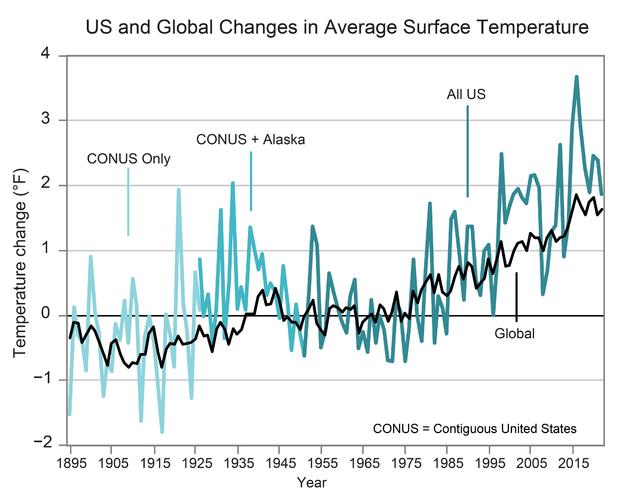Biden's Fifth National Climate Assessment found these 5 key ways climate change is affecting the entire U.S.
A new report released by the Biden administration drives home a warning that scientists have been issuing for years — nowhere in the U.S. is safe from the effects of climate change. The Fifth National Climate Assessment, released Tuesday, provides a grim overview of the impact on the nation as climate change worsens, and says current efforts and investments to address it remain "insufficient." But it also offers some options for a more hopeful future.
"Anyone who willfully denies the impact of climate change is condemning the American people to a very dangerous future," Pres. Biden said on Tuesday in remarks about the assessment, which was reviewed by hundreds of experts. "The impacts we're seeing are only going to get worse, more frequent, more ferocious, and more costly."
Here are five of the key takeaways from the report.
1. The U.S. is experiencing climate change at rates "unprecedented over thousands of years"
Just last week, it was announced that data compiled by the European Union's Copernicus Climate Change Service shows 2023 is "virtually certain" to be the hottest year ever observed on Earth. From January to October this year, average temperatures on the planet were 1.43 degrees Celsius above the pre-industrial average — a level close to the 1.5 degree warming threshold scientists have warned would cause significant impacts to people worldwide.
That's because temperature plays a vital role in natural processes on the planet that affect weather conditions, particularly when it comes to extreme events. Hotter air temperatures lead to more frequent and intense droughts and warmer oceans contribute to heavier precipitation and more powerful storms.
Greenhouse gas emissions, which mostly come from the burning of fossil fuels such as oil and coal, are a primary driver of this temperature increase. And the most recent National Climate Assessment found that globally, those human-caused emissions have continued to increase worldwide despite long-standing warnings.
"Many of the climate conditions and impacts people are experiencing today are unprecedented for thousands of years," the report says.
Greenhouse gas levels, for example, are "higher than at any time in at least the past 800,000 years," the report states, while the rate of sea level rise in the 20th century — a result of melting sea ice — "was faster than in any other century in at least the last 3,000 years." And global temperature "has increased faster in the past 50 years than at any time in at least the past 2,000 years."
The ripple effects can be seen in the extreme weather events happening across the U.S. and around the world.
While record cold events have declined, the report says, "the frequency, intensity and duration of extreme heat have increased" across the entire country.
2. U.S. has reduced greenhouse gas emissions — but not enough to stop climate change impacts
One of the more positive aspects of the report was that greenhouse gas emissions in the U.S. declined 12% between 2005 and 2019 as the country reduced its reliance on coal and increased renewable energy usage. Efforts to further reduce those emissions are happening in every U.S. region. However, to truly prevent the worst impacts of climate change, the U.S. and other nations would need to reach net zero emissions of carbon dioxide — the primary greenhouse gas produced by humans — and see "deep reductions" in other greenhouse gases.
When these gases are put into the atmosphere, they essentially create a thick blanket that traps heat radiated from the sun, warming the atmosphere. Even if emissions were to stop today, it would take years for global temperatures to decline, and the impacts already being seen — sea level rise and an array of health issues among them — would continue.
"Once CO2 emissions reach net zero, the global warming driven by CO2 is expected to stop: additional warming over the next few centuries is not necessarily 'locked in' after net CO2 emissions fall to zero," the report says. "However, global average temperatures are not expected to fall for centuries unless CO2 emissions become net negative, which is when CO2 removal from the atmosphere exceeds CO2 emissions from human activities."
To limit global warming at a threshold that would prevent the most devastating impacts of climate change, carbon dioxide emissions would have to reach net zero within 30 years or so, and our country's actions would need to accelerate.
"The current rate of decline [in the U.S.] is not sufficient to meet national and international climate commitments and goals," the report states. "... [They] would have to decline by more than 6% per year on average ... by comparison, U.S. greenhouse gas emissions decreased by less than 1% per year on average between 2005 and 2019."
3. Every region in the U.S. is already feeling the impacts of climate change — and it's going to get worse
The National Climate Assessment made one thing clear when it comes to greenhouse gas emissions: even if they "fall substantially, the impacts of climate change will continue to intensify over the next decade."
"All U.S. regions are already experiencing increasingly harmful impacts," the report says, adding that "...adverse impacts already far outweigh any positive effects and will increasingly eclipse benefits with additional warming."
Many of the impacts of climate change are only going to grow more intense over the next seven years, the report warned, outlining "impacts of significant concern" to every region in the country.
In the Northeast, the most pressing issues through 2030 are expected to be extreme weather damaging critical infrastructure, warming temperatures shifting coastal and marine species, and overburdened communities being disproportionately impacted by extreme heat and flooding. In the Southeast, sea level rise and coastal flooding are expected to cause more damage, while extreme heat will threaten human health and water supplies will be impacted by both heavy rain and drought — a situation recently experienced in New Orleans.
Hawaii, which has been devastated by wildfires this year, is expected to suffer from water supply issues as well. Agriculture systems in the Great Plains are expected to suffer from water issues and increased wildfire risk.
And whatever happens in one region will impact what happens in another, the report notes. This was seen earlier this year, when smoke from wildfires in Canada caused some U.S. cities to experience the worst air quality in the world. Climate change-induced agricultural stressors can also negatively influence global food supply chains and where humans are able to live.
"The risk of two or more extreme events occurring simultaneously or in quick succession in the same region-known as compound events-is increasing," the report says. "Climate change is also increasing the risk of multiple extremes occurring simultaneously in different locations that are connected by complex human and natural systems."
4. Climate change will continue to have "profound negative effects on human health" — particularly for overburdened communities
The health impacts of climate change are already being felt nationwide, and as the climate crisis worsens, it's communities experiencing "systemic discrimination, exclusion and under- or disinvestment" that will feel it the most, the report says.
Those living in lower-income communities or communities of color, for example, tend to have worse access to resilient infrastructure, greenery that helps provide shade and cooling from extreme heat, health care providers and clean water — all of which will only become more essential as temperatures and extreme weather events increase. A changing climate is also expected "to make food less available and more expensive," a problem that will likely "disproportionately affect the nutrition health of women, children, older adults, and low-wealth communities," the report states.
As noted by the assessment, low-income neighborhoods are "hotter on average," and areas made up of primarily people of color tend to have the highest exposure to flooding.
In a press release by the Department of Health and Human Services on Tuesday, the department said reiterated that "climate change has profound negative effects on human health."
Among the impacts are higher rates of heat-related illness and death, the spread of infectious diseases, worsening air quality, increases in pregnancy-related issues and higher rates of pulmonary, neurological and cardiovascular diseases, the department said. People of color, those with disabilities and those in the LGBTQ communities are among the most at-risk for these issues.
Reducing global emissions is essential in increasing health benefits, the department said.
"Each metric ton of CO2 reduced is estimated to bring about health benefits in the U.S. that are valued between $8 to $430 (in 2022 dollars), mainly from avoided premature death," HHS said. "These health benefits outweigh costs for many Greenhouse Gas (GHG) mitigation measures."
5. The U.S. is adapting to climate change, but investments are "insufficient" to reduce the risks
While the assessment "lays out the threats and dangers" related to climate change, President Biden said Tuesday that it also highlights that "solutions are within reach." One of the most promising aspects of the assessment is that efforts to address climate change have increased and are underway in every part of the country.
"We just have to keep at it and we need to do more and move faster," Mr. Biden said. "And we have the tools to do it."
With enough action, "both adaption and mitigation goals" can be achieved, the report says. Expanding access to renewable energy, for example, could both reduce greenhouse gas emissions and also improve climate resilience.
This has been seen in extreme weather events, like last year's Hurricane Ian. While the storm slammed Southwest Florida, one local community got through relatively unscathed: Babcock Ranch is 100% solar power-based and its infrastructure was built to withstand winds of up to 145 mph.
Other areas have adopted mitigation and adaptation methods also created plans to better manage land, ecosystems and water reservoirs.
However, more needs to be done.
"Despite an increase in adaptation actions across the country, current adaptation efforts and investments are insufficient to reduce today's climate-related risks and keep pace with future changes in the climate," the assesment says. "Accelerating current efforts and implementing new ones that involve more fundamental shifts in systems and practices can help address current risks and prepare for future impacts."







